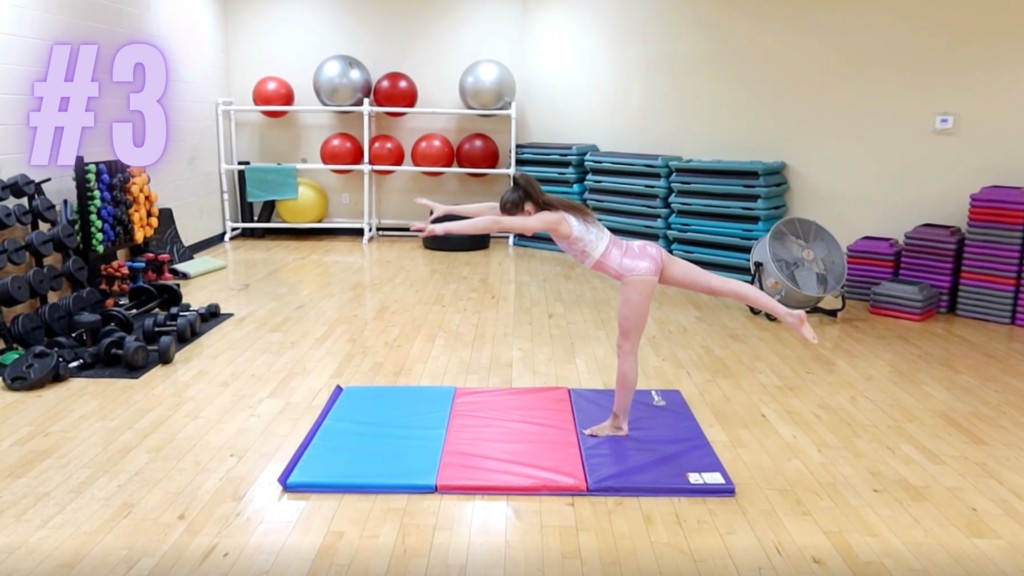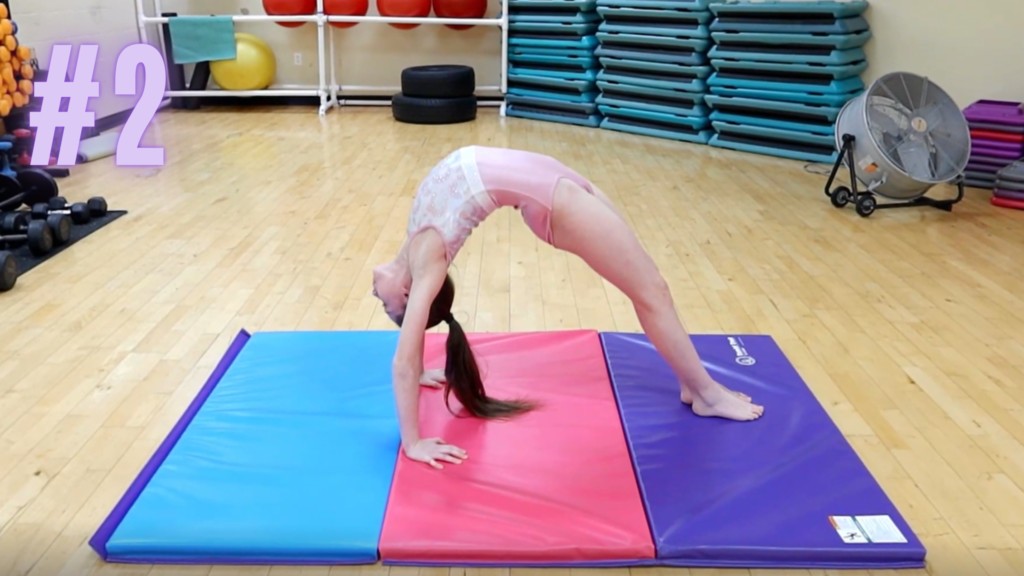Learning How To Learn Gymnastics At Home can be an enriching experience, building strength, flexibility, and coordination. Whether you’re a beginner or looking to refine your skills, LEARNS.EDU.VN offers the resources and guidance you need for effective gymnastics training in your own space. Discover essential techniques, safety tips, and progressive exercises to enhance your gymnastics journey, supplemented with flexibility exercises and core strength workouts, all designed to help you excel.
1. Understanding the Fundamentals of Gymnastics at Home
Gymnastics is a sport that combines strength, flexibility, balance, and coordination. Starting at home can be a convenient way to build a solid foundation. Understanding the core principles and basic skills is crucial for safe and effective training.
1.1. Essential Gymnastics Principles
Gymnastics is rooted in a few key principles. According to USA Gymnastics, proper form, body awareness, and progressive training are fundamental to success and injury prevention.
- Proper Form: Maintaining correct alignment in each movement.
- Body Awareness: Understanding your body’s position in space.
- Progressive Training: Gradually increasing the difficulty of exercises.
1.2. Setting Up a Safe Training Environment
Safety should be your top priority when learning gymnastics at home. Ensure you have adequate space and appropriate equipment.
- Clear Space: A minimum of 10×10 feet of open area free from obstacles.
- Mats: Use gymnastics mats or soft surfaces to cushion landings. According to the American Academy of Pediatrics, mats reduce the risk of impact-related injuries.
- Supervision: If possible, have a spotter, especially when learning new or challenging skills.
- First Aid: Keep a basic first aid kit nearby for minor injuries.
2. Mastering Basic Gymnastics Skills
Before attempting advanced moves, it’s important to master the basics. These foundational skills will build the necessary strength, flexibility, and coordination.
2.1. Forward and Backward Rolls
Rolls are fundamental in gymnastics. They teach body control and spatial awareness.
- Forward Roll:
- Start in a squatting position with your hands shoulder-width apart on the mat.
- Tuck your chin to your chest and round your back.
- Push off with your feet and roll forward, placing the back of your neck on the mat.
- Keep your body tucked and roll onto your feet, returning to a standing position.
- Backward Roll:
- Start in a squatting position.
- Reach your hands back, placing them shoulder-width apart with your fingers pointing towards your shoulders.
- Tuck your chin to your chest and roll backward, pushing off with your hands to support your neck.
- Roll onto your feet, returning to a standing position.
2.2. Handstands
Handstands are essential for developing upper body strength and balance.
- Preparation:
- Start by practicing against a wall.
- Place your hands shoulder-width apart on the floor, about a foot away from the wall.
- Kick up one leg at a time, using the wall for support.
- Technique:
- Engage your core and maintain a straight line from your hands to your feet.
- Keep your head neutral and look slightly forward.
- Practice holding the handstand for 10-30 seconds.
- Progression:
- Gradually move away from the wall as your strength and balance improve.
- Work on freestanding handstands, focusing on maintaining proper form.
2.3. Cartwheels
Cartwheels improve coordination, flexibility, and spatial awareness.
- Starting Position:
- Stand with one leg forward and your arms extended overhead.
- Lean forward and place one hand down, followed by the other, in a straight line.
- Execution:
- Kick your legs over your head, one at a time, maintaining a straight line with your body.
- Land on one foot, followed by the other, returning to the starting position.
- Tips:
- Keep your legs straight and pointed.
- Maintain a tight core for stability.
- Practice on a straight line to improve accuracy.
2.4. Bridges
Bridges enhance back flexibility and shoulder strength.
- Starting Position:
- Lie on your back with your knees bent and your feet flat on the floor.
- Place your hands shoulder-width apart near your ears with your fingers pointing towards your shoulders.
- Execution:
- Push through your hands and feet to lift your body off the floor.
- Arch your back as much as possible, aiming to create a straight line from your hands to your feet.
- Hold the bridge for 10-30 seconds.
- Progression:
- Work on increasing the duration of the hold.
- Practice rocking back and forth in the bridge to improve flexibility.
2.5. Leaps
Leaps are essential for developing lower body power and flexibility.
- Starting Position:
- Stand with one leg forward and your arms extended.
- Step forward onto your front leg and push off with your back leg.
- Execution:
- Jump into the air, splitting your legs as wide as possible.
- Aim to create a straight line from your front foot to your back foot.
- Land softly on your front leg, followed by your back leg.
- Tips:
- Focus on height and split position.
- Practice flexibility drills to improve your split.
3. Flexibility Training for Gymnastics
Flexibility is a cornerstone of gymnastics. Regular stretching can improve range of motion and prevent injuries.
3.1. Importance of Flexibility
Flexibility allows gymnasts to perform a wider range of skills with greater ease and reduces the risk of strains and tears. According to a study in the Journal of Strength and Conditioning Research, flexibility training enhances athletic performance.
3.2. Effective Stretching Exercises
- Hamstring Stretch:
- Sit on the floor with one leg extended and the other bent.
- Reach towards your toes, keeping your back straight.
- Hold for 30 seconds.
- Quadriceps Stretch:
- Stand and hold onto a chair or wall for balance.
- Grab your foot and pull it towards your glutes.
- Hold for 30 seconds.
- Shoulder Stretch:
- Extend one arm across your body.
- Use your other arm to gently pull it closer.
- Hold for 30 seconds.
- Back Stretch:
- Lie on your back with your knees bent.
- Gently twist your knees to one side, keeping your shoulders on the floor.
- Hold for 30 seconds.
- Split Stretch:
- Start in a lunge position.
- Slide your front foot forward and lower your back knee towards the floor.
- Continue sliding forward until you reach a full split.
- Hold for 30 seconds.
3.3. Dynamic vs. Static Stretching
- Dynamic Stretching: Involves movement and prepares the muscles for activity. Examples include arm circles, leg swings, and torso twists.
- Static Stretching: Holding a stretch for an extended period. Best performed after a workout to improve flexibility.
4. Strength Training for Gymnastics
Strength training is vital for executing gymnastics skills with power and control.
4.1. Core Strength Exercises
A strong core is essential for stability and control in gymnastics movements.
- Plank:
- Start in a push-up position with your forearms on the floor.
- Engage your core and maintain a straight line from your head to your heels.
- Hold for 30-60 seconds.
- Crunches:
- Lie on your back with your knees bent and your feet flat on the floor.
- Place your hands behind your head and lift your shoulders off the floor.
- Focus on engaging your abdominal muscles.
- Repeat for 15-20 reps.
- Leg Raises:
- Lie on your back with your legs extended.
- Lift your legs off the floor, keeping them straight.
- Lower your legs back down slowly.
- Repeat for 15-20 reps.
- Russian Twists:
- Sit on the floor with your knees bent and your feet slightly off the floor.
- Lean back slightly and twist your torso from side to side.
- Hold a weight or medicine ball for added resistance.
- Repeat for 15-20 reps.
4.2. Upper Body Strength Exercises
Upper body strength is crucial for skills like handstands and bars.
- Push-Ups:
- Start in a plank position with your hands shoulder-width apart.
- Lower your body towards the floor, keeping your back straight.
- Push back up to the starting position.
- Repeat for 10-15 reps.
- Pull-Ups:
- Grip a pull-up bar with your hands shoulder-width apart.
- Hang with your arms fully extended.
- Pull yourself up until your chin is above the bar.
- Lower yourself back down slowly.
- Repeat for as many reps as possible.
- Dips:
- Use parallel bars or a sturdy chair.
- Lower your body down, bending your elbows.
- Push back up to the starting position.
- Repeat for 10-15 reps.
4.3. Lower Body Strength Exercises
Lower body strength provides the power for jumps and leaps.
- Squats:
- Stand with your feet shoulder-width apart.
- Lower your body as if sitting in a chair, keeping your back straight.
- Push back up to the starting position.
- Repeat for 15-20 reps.
- Lunges:
- Step forward with one leg and lower your body until both knees are bent at 90 degrees.
- Push back up to the starting position.
- Repeat with the other leg.
- Repeat for 10-15 reps per leg.
- Calf Raises:
- Stand with your feet flat on the floor.
- Raise up onto your toes, engaging your calf muscles.
- Lower back down slowly.
- Repeat for 20-25 reps.
5. Integrating Gymnastics Skills into Daily Routine
Consistency is key to improving your gymnastics skills. Incorporate short practice sessions into your daily routine.
5.1. Sample Daily Schedule
| Time | Activity | Duration | Description |
|---|---|---|---|
| 7:00 AM | Warm-up | 10 mins | Light cardio, such as jumping jacks and arm circles |
| 7:10 AM | Flexibility Training | 15 mins | Static stretches, including hamstring, quadriceps, and shoulder stretches |
| 7:25 AM | Skill Practice | 20 mins | Handstands, cartwheels, and rolls |
| 7:45 AM | Strength Training | 15 mins | Plank, push-ups, and squats |
| 8:00 AM | Cool-down | 5 mins | Gentle stretches to reduce muscle soreness |


5.2. Tips for Staying Motivated
- Set Goals: Establish specific, measurable, achievable, relevant, and time-bound (SMART) goals.
- Track Progress: Keep a record of your workouts and achievements.
- Find a Training Partner: Working with someone can provide motivation and accountability.
- Reward Yourself: Celebrate your accomplishments with non-food rewards, such as new workout gear or a relaxing activity.
6. Advanced Gymnastics Skills to Practice at Home
Once you’ve mastered the basics, you can move on to more advanced skills.
6.1. Back Handspring
The back handspring requires strength, flexibility, and coordination.
- Prerequisites: Solid back bridge and strong handstand.
- Technique:
- Start in a standing position with your arms overhead.
- Sit back as if sitting in a chair and swing your arms down and back.
- Jump backward, pushing off with your feet and reaching your hands towards the floor.
- Snap your legs over your head and land on your feet.
- Safety: Practice with a spotter and on a soft surface.
6.2. Front Handspring
Similar to the back handspring, the front handspring requires a good handstand and strong core.
- Prerequisites: Strong handstand and good body control.
- Technique:
- Start in a standing position and run forward.
- Place your hands on the floor and kick your legs over your head.
- Push off with your hands and snap your legs down to land on your feet.
- Safety: Practice with a spotter and on a soft surface.
6.3. Aerial Cartwheel
An aerial cartwheel is a cartwheel performed without hands touching the ground.
- Prerequisites: Solid cartwheel and good body awareness.
- Technique:
- Start in a cartwheel position.
- As you kick your legs over, push off with your legs and lift your hands off the ground.
- Land on one foot, followed by the other.
- Safety: Practice on a soft surface and with a spotter.
7. Utilizing Online Resources and Tools
Many online resources and tools can assist with your gymnastics training.
7.1. Online Tutorials and Courses
Websites like LEARNS.EDU.VN provide detailed tutorials and courses for gymnasts of all levels. These resources offer step-by-step instructions, demonstrations, and personalized feedback.
7.2. Gymnastics Apps
Gymnastics apps can help track progress, provide workout plans, and offer tips on technique. Examples include:
- Skilltrakker: Provides structured gymnastics programs for home practice.
- MyFitnessPal: Tracks calorie intake and provides nutritional guidance.
7.3. Social Media Communities
Joining online gymnastics communities can provide support, motivation, and valuable advice from experienced gymnasts and coaches.
8. Addressing Common Challenges and Solutions
Learning gymnastics at home comes with its own set of challenges. Here’s how to tackle them:
8.1. Lack of Equipment
Challenge: Limited access to professional gymnastics equipment.
Solution:
- Creative Alternatives: Use household items like sturdy chairs for dips or a low beam.
- Gradual Investment: Slowly invest in essential equipment like mats and resistance bands.
8.2. Maintaining Motivation
Challenge: Staying motivated without the structure of a gym environment.
Solution:
- Set Achievable Goals: Break down larger goals into smaller, manageable tasks.
- Join Online Communities: Share progress and get encouragement from others.
- Track Progress: Use a journal or app to monitor your achievements and stay motivated.
8.3. Ensuring Safety
Challenge: Minimizing the risk of injury without professional supervision.
Solution:
- Proper Warm-Up: Always start with a thorough warm-up to prepare your muscles.
- Use Mats: Invest in quality gymnastics mats to cushion falls.
- Seek Feedback: Record yourself and ask experienced gymnasts or coaches for feedback on your technique.
9. Nutrition and Recovery for Gymnasts
Proper nutrition and recovery are critical for maximizing performance and preventing injuries.
9.1. Balanced Diet
A balanced diet for gymnasts should include:
- Protein: Essential for muscle repair and growth (e.g., lean meats, dairy, beans).
- Carbohydrates: Provide energy for training (e.g., whole grains, fruits, vegetables).
- Healthy Fats: Support hormone production and overall health (e.g., avocados, nuts, olive oil).
9.2. Hydration
Staying hydrated is crucial for performance and recovery. Gymnasts should drink plenty of water throughout the day, especially before, during, and after training.
9.3. Rest and Recovery
Adequate rest and recovery are essential for preventing overtraining and injuries. Aim for 7-9 hours of sleep per night and incorporate rest days into your training schedule.
10. Advanced Training Techniques and Drills
To continually improve, gymnasts should incorporate advanced training techniques and drills into their routines.
10.1. Plyometric Training
Plyometric exercises enhance power and explosiveness, crucial for jumps and tumbling skills.
- Box Jumps: Jump onto a box of varying heights to improve lower body power.
- Depth Jumps: Jump off a box and immediately jump upward upon landing.
10.2. Interval Training
Interval training improves cardiovascular fitness and endurance.
- Sprinting Intervals: Alternate between high-intensity sprints and periods of rest or low-intensity jogging.
- Circuit Training: Perform a series of exercises with minimal rest in between.
10.3. Mental Training
Mental training is just as important as physical training. Techniques include:
- Visualization: Mentally rehearse routines to improve confidence and performance.
- Positive Self-Talk: Use positive affirmations to build confidence and focus.
- Mindfulness: Practice mindfulness to stay present and manage stress.
By following these steps and incorporating the resources available at LEARNS.EDU.VN, you can effectively learn gymnastics at home and achieve your fitness goals. Remember to prioritize safety, consistency, and proper technique to maximize your progress and prevent injuries.
Learning gymnastics at home can be a fulfilling journey with the right approach and resources. LEARNS.EDU.VN is dedicated to providing comprehensive guidance and support for gymnasts of all levels. Whether you’re aiming to master basic skills or advance to more complex routines, we offer expert insights, personalized training plans, and a supportive community to help you succeed. Explore our extensive library of articles, tutorials, and courses to unlock your full potential in gymnastics, supplemented with core conditioning exercises and flexibility routines to enhance your skills.
Ready to take your gymnastics training to the next level? Visit LEARNS.EDU.VN today to explore our resources and start your journey towards gymnastics success. For more information, contact us at 123 Education Way, Learnville, CA 90210, United States, Whatsapp: +1 555-555-1212, or visit our website at LEARNS.EDU.VN.
FAQ: Learning Gymnastics at Home
-
Is it safe to learn gymnastics at home?
Yes, if you take the necessary precautions, such as using mats, ensuring a clear space, and having a spotter when possible. -
What equipment do I need to start gymnastics at home?
Essential equipment includes gymnastics mats, comfortable workout clothes, and a water bottle. As you progress, you may want to add items like resistance bands and a balance beam. -
How often should I practice gymnastics at home?
Consistency is key. Aim for at least 3-5 practice sessions per week, each lasting 30-60 minutes. -
Can I learn advanced gymnastics skills at home?
Yes, but it’s important to master the basics first and practice with a spotter for safety. -
What are some good warm-up exercises for gymnastics?
Effective warm-up exercises include jumping jacks, arm circles, leg swings, and torso twists. -
How important is flexibility in gymnastics?
Flexibility is crucial for performing gymnastics skills with proper form and reducing the risk of injury. -
What are some common mistakes to avoid when learning gymnastics at home?
Common mistakes include skipping warm-ups, attempting skills beyond your current ability, and neglecting safety precautions. -
How can I stay motivated when practicing gymnastics at home?
Set realistic goals, track your progress, find a training partner, and reward yourself for achieving milestones. -
What are some good resources for learning gymnastics at home?
Websites like learns.edu.vn, online tutorials, gymnastics apps, and social media communities can provide valuable guidance and support. -
How can I prevent injuries when practicing gymnastics at home?
Always warm up before practice, use proper technique, practice with a spotter, and listen to your body. If you experience pain, stop and rest.

